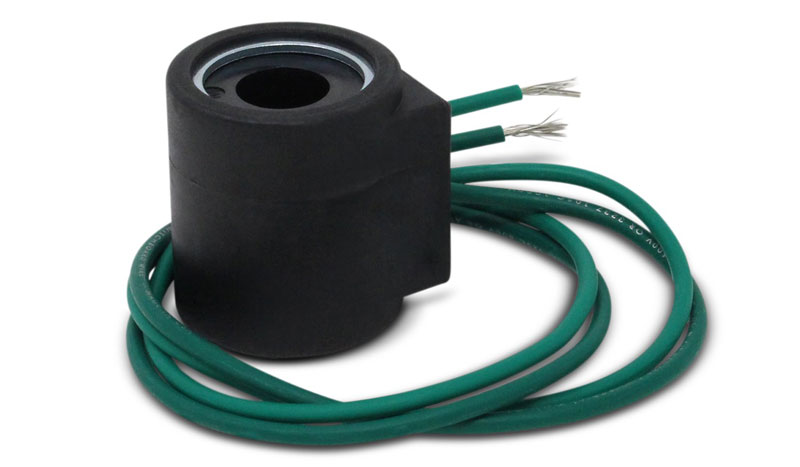There are many types of solenoid valves. The solenoid valves are used for controlling either the gas or the liquid (oil, water).
For most of the solenoid valve, the solenoid valve coil is set within the valve body. It is separable.
The valve core is made of magnetic material. While the solenoid valve coil is electrified, the valve core will generate a magnetic force which activates the core itself to move. In this way, the valve is controlled to open and close.
Like other solenoid coils, the solenoid valve coil is an inductor. It is a wounded wire in a helix shape. It wraps around a metal rod which is called the armature.
The core definitions
- the inductance value (L): this value (L) reflects the inherent characteristic which has nothing to do with the current. Except for special inductor coil (color code inductor), this value won’t be marked. Instead, it is marked with a special name.
- inductive reactance (XL): the reactance of the inductive coil to the alternating current is called inductive reactance. The unit is Ohm. The formula of inductive reactance(XL) and inductive valve(L) and alternative current frequency(f) is XL=2πfL.
- quality factor (Q): the Q-factor defines a physical quantity of the coil quality. The Q-factor is the ration between inductive reactance (XL) and equivalent resistance (R), e.g. Q=XL/R. The higher the Q-factor is, the less the circuit loses. The value normally ranges from decades to hundreds.
- distributed capacitance: the capacitances that distributed between the turns, between the turn and shield, are called distributed capacitance.
The classification of solenoid valve coil
- single layer coil.
The wire is wrapped around a paper tube or a bakelite. A typical example is medium-wave antenna coil in the transistor radio.
- duolateral coil.
The surface of the coil is not parallel with the rotating surface but intersected at an angle. The duolateral coil has advantages of small size, less distributed capacitance, large inductance value.
- ferrite core and iron powder core coil.
The inductance value is decided by whether there is a core or not. To insert ferrite core into the empty coil can increase the inductance value as well as the coil quality.
- copper core coil.
The copper core coil is widely used in ultra-short wave applications. The inductance is changed by the positions of the copper core by rotating it. This adjustment is convenient and durable.
- color code inductor
This type of coil has a fixed inductance value which is marked by color circle.
- choking coil
It restricts the alternating current from passing through. There are high frequency choking coil and low frequency choking coil.
- deflection coil
A deflection coil is used in a TV set for the circuit output load. It requires high sensitivity, even magnetic field, high Q-factor, small size and low price.
The function of a solenoid valve coil
The armature inside the coil can move as the valve is electrified. The plunger is moving along with the armature so that the valve can be controlled open and close.
The so-called “wet” or “dry” solenoid refers to the environment where the valve is working at. There is no difference in terms of the valve motion.
The inductance value of the hollow coil is not the same as a coil with armature. The former is smaller than the latter. When turned on with alternating current, the impedance is also different. For the same coil, if electrified with alternating current with the same frequency, the inductance value alters as the armature moves, and so does the impedance.
The reasons of solenoid valve coil overheat
When the coil is electrified, a closed magnetic circuit is generated. It is designed to suit the maximum inductance value. The heat that is generated is inevitable. However, if the armature can’t move smoothly when electrified, the coil’s inductance and the impedance drop down. As a result, the ampere increases. This is the reason to cause coil overheat.
To be specific, there are two reasons:
- the external reason: the stability of the solenoid valve coil depends largely on the purity of the medium. As time goes by, the particles in the medium will attach to the valve core. If this happens, the valve is stuck, FS=0, I=6i, meaning that the current will be 6 times larger. As a result, the coil will burn out.
- Internal reason: the gas between the valve sleeve and the valve core is very small (not greater than 0.008mm). It is easy to get stuck when the foreign matter enters or when the grease is not sufficient.
The reasons of solenoid valve coil short circuit or open circuit
If the resistance tested is close to 0 or infinity, it indicates that the coil is either short circuit or open circuit. However, if the resistance is normal, it doesn’t necessarily prove that the coil is working properly. In some cases, you will need to test it further to eliminate other potential troubles.
How to test a solenoid valve coil?
Whether a solenoid valve coil is good or not can be tested by a multimeter. An ordinary coil normally has a resistance of around 100 Ohm. If the result tested is infinity, it means the coil is broken. If no multimeter is available, you can simply put an iron material object above the coil, as the electrified coil can attract the iron objects. If the coil fails to attract, you may need to repair it.
